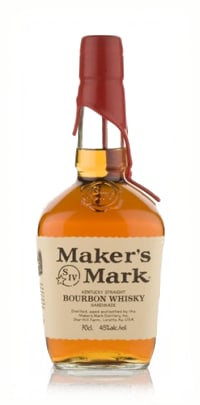About Maker's Mark
Beam Suntory produces Maker's Mark, a small-batch bourbon whiskey, in Loretto, Kentucky. It is marketed in square bottles that are sealed with red wax and is bottled at 90 U.S. proof (45% alcohol by volume). The distillery offers tours and is a stop on both the Kentucky Bourbon Trail and the American Whiskey Trail. Because no rye is used in the mash, Maker's Mark is unique. Red winter wheat (16%), maize (70%) and malted barley (14%) are all used in Maker's Mark's mash bill in place of rye. Samuels supposedly designed seven potential mash bills for Maker's Mark during the development stage. He produced a loaf of bread from each recipe instead of distilling and aging them all for taste, and the version without rye was deemed to have the greatest flavor. Owner of Stitzel-Weller Pappy Van Winkle, whose distillery created the wheated Old Fitzgerald and W. L. Weller bourbons, also provided Samuels with a great deal of advice and ideas. Maker's Mark is matured for approximately six years before being bottled and sold after corporate tasters deem it to be ready. One of the few distilleries, Maker's Mark, rotates the barrels from the top to lower floors of the aging warehouses during the maturing process to balance out temperature variations. [25] Rotating the barrels keeps the bourbon consistent in quality and flavor throughout all of the barrels since the top levels are subject to the largest temperature swings throughout the year. Small batch bourbon is how Maker's Mark is promoted. The majority of makers of so-called small batch Bourbons do not define the phrase precisely. A classic definition of bourbon, according to Maker's Mark's manufacturer, is 'a bourbon that is produced/distilled in modest amounts of around 1,000 gallons or less (20 barrels) from a mash bill of around 200 bushels of grain.' Red wax is used to seal the square bottles in which Maker's Mark is packaged for sale. Marjorie 'Margie' Samuels, the wife of T. William Samuels, came up with the idea for the wax dipping that gives the whiskey's bottle its characteristic appearance. She also came up with the whiskey's name and label. In 1959, it was released onto the market. Three different versions are sold: the original, which is bottled at 90 U.S. proof (45% alcohol by volume); a seasonal, limited-edition mint julep taste; and Maker's 46, which is flavored by adding seared French oak staves to the standard charred white oak barrel at the conclusion of its age. Maker's Mark is currently offered with up to 57% alcohol concentration as of 2021. (114 proof). One of the few American-made whiskies that utilizes the Scottish spelling of 'whisky' rather of the more common American 'whiskey' is Maker's Mark, along with George Dickel and Old Forester.





